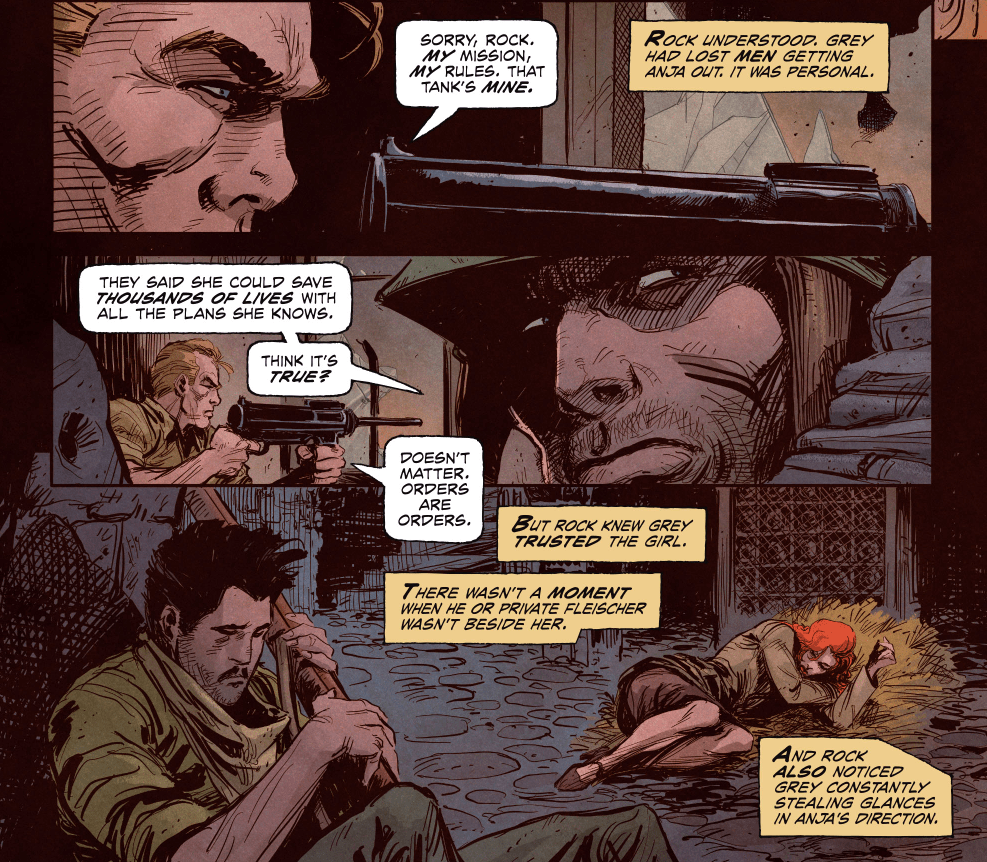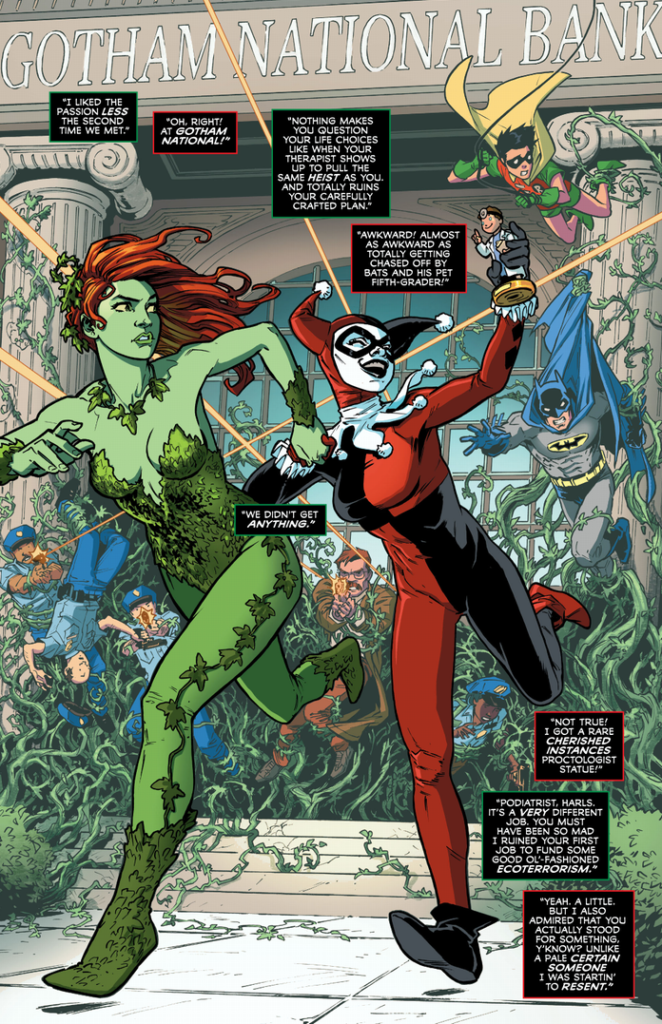
Comics Corner – A Particularly Queer Valentine
Holiday specials in comics have quite the lineage, dating back to the 1940s, the ‘Golden Age of Comics’. In recent years, publishers have brought the idea back, throwing characters into quirky stories based around Halloween or Christmas or – in the case of the recently released DC Love is a Battlefield – Valentine’s Day.
The 80-page giant sized issue is an anthology special featuring ten short stories exploring relationships and different notions of love between some of DC’s best-known superheroes. There’s love enduring over multiple lifetimes, in a Hawkman/Hawkwoman story by writer Cavan Scott and artists Jose Luis and Jonas Trinidade; burgeoning love in a first date between Teen Titans members Kid Flash and Red Arrow, by Marquis Draper and Pop Mhan; how love can transition into respect and friendship in a tale focussing on ex-lovebirds Nightwing and Starfire, by Sina Grace and Karl Mostert; and even an utterly non-romantic ‘relationship’ between Daily Planet editor Perry White and Amanda Waller, director of the Suicide Squad, in a short by Mark Russell and Nik Virella.

What really stands out though is how queer-friendly the special is. Three of the ten stories explore LGBTQ+ characters and themes, with at least two of them paving the way for future representation.
The first is a Wonder Woman short, Bittersweet, with the Amazon princess out on a Valentine’s dinner date with her paramour Steve Trevor. Written by Crystal Frasier, with art by Juan Gedeon, the episode sees the couple’s date interrupted by the Blue Snowman.
“The who?”, some of you may be asking, and that’s a fair question, as the Blue Snowman is one of Wonder Woman’s less recognisable enemies. Despite first appearing back in 1946, the ice-powered villain has only had a handful of appearances since. A chemical and engineering genius, the Blue Snowman used an advanced suit of armour and a proprietary form of chemical ice known as ‘Blue Snow’ to commit a raft of crimes. However, the Blue Snowman was actually the female schoolteacher, Byrna Brilyant, adopting a masculine identity to shroud her activities. Every appearance that the character made afterwards would keep this archetype – a female villain using a male identity.
In Bittersweet, Frasier and Gedeon take the idea to a more logical and natural place – Brilyant is genderfluid. After Wonder Woman and Trevor have stopped the Blue Snowman’s rampage, Trevor expresses amazement that Diana’s “snowman villain is a girl?!” Angered, she replies “Shut up! I didn’t name myself Blue Snowman because I wanna be called a girl!”
“Sometimes I know I’m a guy, okay? Sometimes I’m not”, they continue. They reveal the reason they hate Valentine’s is because they feel “no one could love a freak who can’t decide if they’re a boy or a girl!” Thankfully, another diner at the restaurant explains that they’re gender-fluid too, and that while it can be tough, it doesn’t make them freaks.

It’s a revelation for Brilyant – and, likely, plenty of readers – who has no idea there’s even terminology to help define what they’re experiencing. It proves a surprisingly sympathetic moment, especially for a niche character making their first appearance in years. While more space to explore this shift for the Blue Snowman would have been welcome, it’s a deft bit of characterisation on Frasier’s part, taking an obscure and potentially problematic ‘genderbent’ character from nearly 80 years ago and making them relevant for a modern readership.
Later in Love is a Battlefield, a Sgt Rock story – Able, by Pornsak Pichetshote and Chris Mooneyham –takes the “battlefield” part literally, following DC’s best-known soldier in a World War II era tale. Trapped behind enemy lines in France, Rock is assisting Sgt Samuel Grey and his last-surviving squadmate Private Jack Fleischer. Pinned in place by a Nazi unit and its Tiger tank, Rock notes Able being unable to keep his eyes off the the beautiful Anja Wagner, a German double agent the soldiers are trying to extract to Allied territory.
However, it’s not Anja that Sam was stealing glances at – it was Jack. Rock only picks up on the distinction when Fleischer sacrifices himself to destroy the Nazi tank, and Grey runs, distraught and crying, to cradle his (implied) lover’s body. Rock observes that only love, “and not getting a fair chance to share it”, warrants that reaction.
Yes, it’s a bit ‘bury your gays‘, but it is an already-bleak WW2 tale. However, Pichetshote wisely uses the moment to reflect on the prejudices of the time, on how military doctors would casually question enlistees whether they liked girls, to weed out “sexual psychopaths” – referring to an actual term used in American psychiatry at the time, which categorised homosexuality as a disorder – and how many men had lied when asked, just to be able to serve their country despite how it would treat them for their sexuality.

The biggest gay focus in the book though is a Harley Quinn/Poison Ivy tale, The Beginning. Written by Tim Seeley with art by Rebekah Isaacs, the eight-page story sees Harley and Ivy remininscing on how they met, and on some of their craziest capers together. It charts from Ivy being assigned to Harley as a patient when the latter was still practicing psychiatry at Arkham Asylum as “merely” Dr Harleen Quinzel, to Harley’s first crime spree after breaking up with the Joker, and through to their crucial role in some major crossover events that, to readers, haven’t even occurred yet.
It’s a touching short, painting a portrait of a lifelong connection between the couple. The back-and-forth dialogue is sweet, filled with the sort of knowing teases and jibes that partners develop over years spent together, while Isaacs’ pages are packed with life and vitality, charting the support and love the pair share. It all ends on a melancholic note, with Harley and Ivy embarking on a new path, but with the promise of a continued future.
Frustratingly, the tale doesn’t actually allow Harley or Ivy to say the words “I love you” to each other, and the only kiss we see is Ivy gently kissing Harley’s forehead. It’s simultaneously touching, romantic, and progressive in having the women recount their lives together, and regressive in not being able to make the screamingly obvious subtext into overt statements. The closest is Ivy saying “I hadn’t liked anyone but plants in… well… ever”, to which Harley says she knew (shades of Han Solo), and allusions to their physical love life, with Ivy recalling she made Harley immune to her toxic physiology so that Harley “lived to touch again”.

The ‘unspoken love’ approach risks a repeat of the controversy surrounding DC’s summer 2020 Pride tweet, which was called out by some fans who perceived the publisher as having sidelined some of its most prominent LGBTQ+ characters. This included reportedly not allowing Sam Humphries, then-writer of the Harley Quinn solo comic, to use Poison Ivy in his stories. DC seemingly still refusing to allow the couple to be a couple – despite their driving off into the sunset in the Harley Quinn animated series – may disappoint readers, especially when Seeley comes as close as possible to making it canon on the page, here.
The canonicity of the stories in Love is a Battlefield is debatable though – for instance, a Batman/Catwoman story references their recent aborted wedding in the main Batman series, and a Green Lantern story taps into the past of both John Stewart and Fatality, whereas the Hawkman/Hawkwoman tale or a Mister Miracle/Big Barda short could fit anywhere or nowhere. That also makes it tough to determine how much of this LGBTQ+ representation will stick, going forwards.
For the Sgt Rock story, it very likely won’t – it’s a one-and-done short; poignant, but more a statement on the sacrifices gay soldiers made in WW2 for a country that didn’t even accept them. Blue Snowman is a better candidate for some permanence, although as a niche villain, it will depend on when they next appear and if whoever writes them at the time wants to explore their new understanding of genderfluid identity. The other handicap here is that villains typically don’t get a lot of personal development outside of villain-centric books, such as Suicide Squad and Secret Six.
However, the best case for some more overt representation lies again with Harley and Ivy. March 2021 sees the launch of Batman: Urban Legends #1, which features a story by writer Stephanie Phillips and artist Laura Braga that’s set to address Harley and Ivy’s relationship. DC’s synopsis for the segment reads, “set just before the launch of her new series. Harley’s determined to sort out her history with Poison Ivy – but first, she’ll have to find her!” Later the same month, Phillips – along with artist Riley Rossmo – kick off a new Harley Quinn ongoing series. While there’s no mention of Ivy in the advance solicitation details for either of the first two issues, it hopefully won’t be long before DC’s most prominent girlfriends are back together – if only the publisher is bold enough to allow it.







